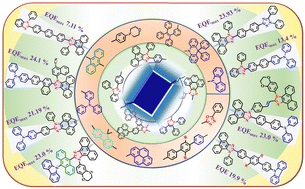Recent progress in imidazole based efficient near ultraviolet/blue hybridized local charge transfer (HLCT) characteristic fluorophores for organic light-emitting diodes
Abstract
Organic light-emitting diodes (OLEDs) are the most successful invention in organic electronics in today's market and have received persistent attention from industrial and scientific communities. OLEDs have rapidly developed into one of the leading technologies for full-color displays and lighting technologies owing to their outstanding features, including good color quality, wide viewing angle, and fascinating flexibility. Imidazole-based heterocyclic moieties have been widely explored for OLED applications, and their flexibility for designing molecules with different functionality is well established. This review summarizes the light-emission mechanisms of electroluminescent fluorophores, followed by a comprehensive review of imidazole-based near-ultraviolet/deep-blue organic fluorophores, fundamental principles regarding molecular design, and the structure–property relationships of hybridized local and charge transfer (HLCT) OLEDs.

- This article is part of the themed collection: Journal of Materials Chemistry C Recent Review Articles


 Please wait while we load your content...
Please wait while we load your content...